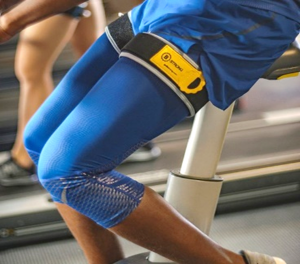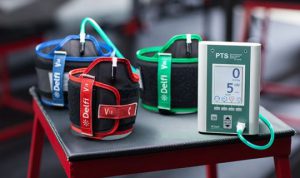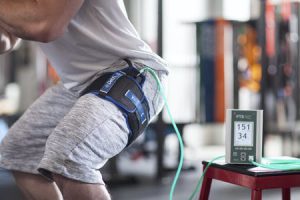Written By: Julie B. Barnett, PT, DPT, MTC
 Blood Flow Restriction Training (BFR): Resistance training with blood flow restriction to the muscles using a strapping cuff such as a thigh or arm wrap that occludes the veins, but not the arteries serving the muscles. Practical use of blood flow restriction training has been shown to increase motor unit recruitment and muscle strength and size at low intensities (30% of 1-rep max, RM.)
Blood Flow Restriction Training (BFR): Resistance training with blood flow restriction to the muscles using a strapping cuff such as a thigh or arm wrap that occludes the veins, but not the arteries serving the muscles. Practical use of blood flow restriction training has been shown to increase motor unit recruitment and muscle strength and size at low intensities (30% of 1-rep max, RM.)
Researchers won a Nobel Prize in Physiology for research on how cells sense and adapt to oxygen availability including 11,000 articles on the effects of decrease in oxygen.
Clinical Implications:
- Increase muscle protein synthesis

- Slow down 30% muscle loss that occurs 2 weeks after injuries
- Start earlier strengthening after procedures/injections/injuries
- Decrease load on joints (osteoarthritis)
- Strengthen sooner and faster
- Increase strength for performance with sports medicine demands/timelines
Proposed Mechanism:
- Increase systemic hormone production
- Increase fast-twitch fiber recruitment
- Increase myostatin repression (facilitates hypertrophy)

- Facilitate muscle growth
BFR Protocol:
- Tourniquet cuff applied to proximal limb (leg or arm)
- Load ~20-30% 1 rep max
- Sets of 30/15/15/15 reps
- 30 second rest between sets
Research
Blood Flow–Restricted Training for Lower Extremity Muscle Weakness due to Knee Pathology: A Systematic Review
Purpose: determine whether BFR improves muscle strength and cross-sectional area for chronic knee related lower extremity atrophy. This study also aimed to determine if BFR can prevent muscle atrophy after knee surgery.
9 Studies Reviewed:
- 3 ACL Reconstructions
- 1 Knee Arthroscopy
- 4 Knee Osteoarthritis
- 1 Patella Femoral Pain
Conclusion: BFR can be more effective at reducing atrophy and improving strength outcomes when used appropriately compared to standard of care in post-operative ACL reconstruction rehab.
Safety Concerns:
- Individualized pressure recommendations for UE/LE
- Blood thinner medications
- History of DVT
- Wider straps are safer than narrow
Practical Points:
- Anoxic environment hurts some. Patients don’t like the pain in the extremity
- Cost of BFR cuffs and objective measurement devices vary
- Training is costly for CCU certification training
- Gym use is less regulated, and use is higher with athletic populations
Explore online continuing education courses from Julie below:
ACSM Guidelines for Exercise for Special Populations
Barber-Westin S, Noyes FR. Blood Flow-Restricted Training for Lower Extremity Muscle Weakness due to Knee Pathology: A Systematic Review. Sports Health. 2019;11(1):69-83. doi:10.1177/1941738118811337
